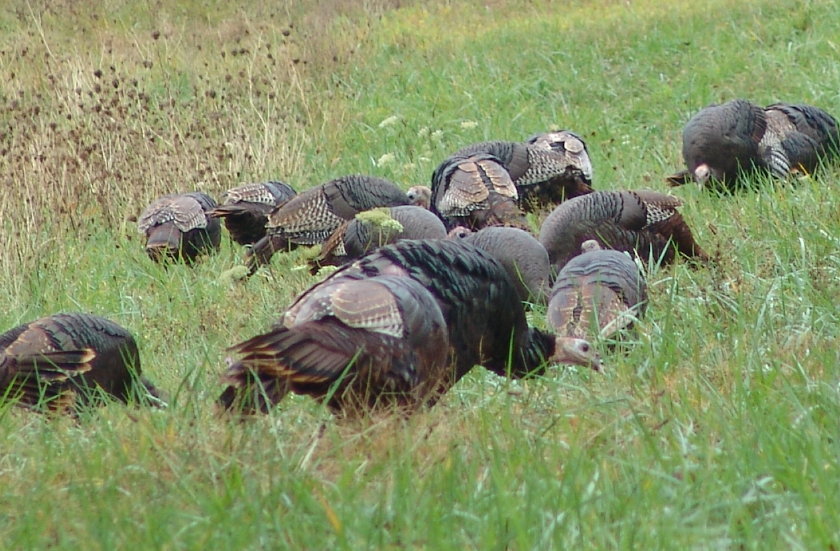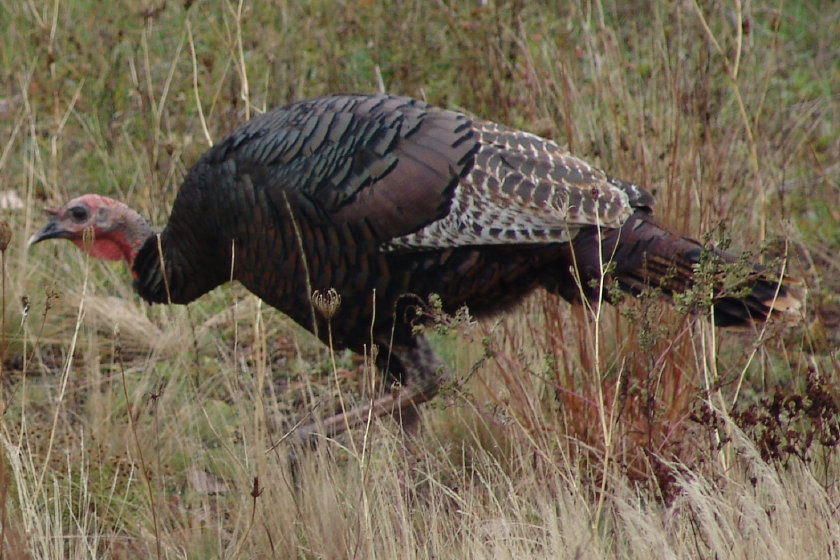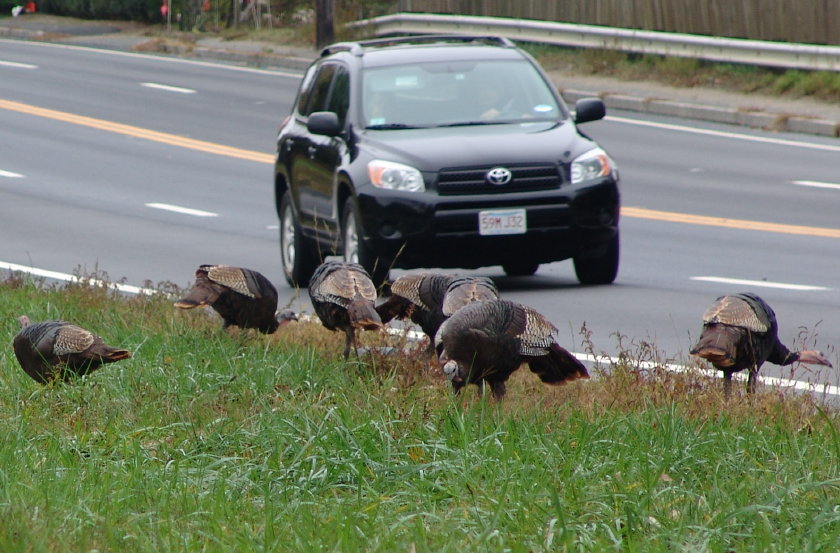Wild Turkey (Meleagris gallopavo) in Eastham, Cape Cod
Ben Franklin: “For my own part I wish the Bald Eagle had not been chosen the Representative of our Country. He is a Bird of bad moral Character. He does not get his Living honestly. You may have seen him perched on some dead Tree near the River, where, too lazy to fish for himself, he watches the Labour of the Fishing Hawk; and when that diligent Bird has at length taken a Fish, and is bearing it to his Nest for the Support of his Mate and young Ones, the Bald Eagle pursues him and takes it from him … I am on this account not displeased that the Figure is not known as a Bald Eagle, but looks more like a Turkey. For the Truth the Turkey is in Comparison a much more respectable Bird, and withal a true original Native of America . . . He is besides, though a little vain & silly, a Bird of Courage, and would not hesitate to attack a Grenadier of the British Guards who should presume to invade his Farm Yard with a red Coat on.”
Rafter of 29 Wild Turkeys Peck Along Cape Highway
Nothing speaks Thanksgiving so well as a turkey’s gobble. We may be a month away from this most original American feast, but the Turtle Journal team heard a raucous rendition of the Thanksgiving serenade as we drove through Eastham. A rafter of wild turkeys … 29 birds in all … pecked the edge of the main Cape Highway near Salt Pond. Engrossed in finding the juiciest morsels, they’d wander recklessly close to traffic, only to snap back as a car whizzed by within inches of their ears. Turkeys are, indeed, a courageous beast as asserted by Ben Franklin.
Wild Turkeys in Woodlands East of Route 6 in Eastham
When we think of wild turkeys, our vision is an idyllic woodsy scene where hints of large feathered images melt into the shadowed background. They are a mirage that evaporates as you approach. That’s precisely what we found the following day as we revisited the Salt Pond site. Yet, on Sunday, they clung to the roadway.
Click Here to View Video in High Quality
Wild Turkeys (Meleagris gallopavo) in Eastham, Cape Cod
Other than at a commercial turkey farm, the Turtle Journal team has never seen a rafter of 29 healthy and well-fed wild turkeys. The good news is clearly that efforts to protect these magnificent birds from over-hunting may be proving effective. The sadder news is that we have so fragmented wild habitat with asphalt roads and suburban landscaping that as populations begin to recover they’re compressed into micro-parcels and constantly find themselves in lethal danger from human activities.
Wild Turkeys Foraging an Open Field in Eastham, Cape Cod
While all those conservation thoughts are true, they do not minimize the pure joy of seeing so many wild turkeys gobbling through the Eastham roadside. We spent about a half hour walking with the rafter as they worked the fields into a nearby woodlands. Once the highway buzz muted in the distance, you could imagine yourself back in Colonial America, right here on the Outer Cape where the Mayflower first dropped anchor before crossing to Plymouth. They, too, would have encountered wild turkeys foraging through open fields, but unlike us, they would have known nothing about these native American birds. Come to think of it, perhaps most Americans still have that ignorance in common with the Pilgrim pioneers.
Wild Turkey Foraging on Outer Cape Cod
NATURAL HISTORY: Wild turkeys are beset by a wide range of predators throughout their lifecycle from egg through poult to adult. These predators include snakes, skunks, opossums, raccoons, coyotes, foxes, dogs, crows, hawks and owls. It would be interesting to know whether the recent upswing in wild turkey numbers on the Outer Cape stems from a reduction in natural predators within their preferred habitat.
Wild turkeys like to forage along the ground within hardwood and mixed woodlands, but they can also be found in adjoining grasslands and swamps. Clearly, pre-Colonial Cape Cod would have offered a paradise for these birds with all their favorite foods in abundance: nuts, seeds, fruit, insects and even salamanders.
At night, wild turkeys may roost in trees. They build crude nests of dry leaves on the ground into which females (hens) lay clutches of 4 to 17 eggs. Almost twice the size of chicken eggs, they’re pale tan in color with dark brown speckles. Hens feed their chicks for only a few days after they hatch, for the young turkeys (poults) quickly learn to fend for themselves within mother-chick flocks of dozens of animals. Males (toms or gobblers) take no role in rearing.Â
In the wild, turkeys live three to four years and reach an adult body size of three and a half to four feet, with a wingspan of four to five feet.  Adults weigh from five to nearly twenty pounds. Mature toms are larger than hens, have longer legs, and grow a “beard” (long black feathers) in the middle of their chest. A male’s head and wattle (growth under the chin) is larger, too. The tom’s snood (fleshy growth on top of the bill) is longer and hangs down the side of his face. Toms gobble; hens click and cluck.  Males strut about, gobbling loudly and holding their heads high. They stick out their chests, fan their large tails and drag their wings on the ground to attract the attention of females. [Sound familiar?  We bet you didn’t know that wild turkeys were metaphors for men!]
Cape Cod Wild Turkey
Once the sky would darken as massive rafters of wild turkeys would spread their wings and fly in unison, according to natural historians. But in the early 1900s, wild turkey populations declined significantly throughout the United States due to habitat destruction and unregulated subsistence hunting. Reintroduction programs begain in the 1940s and the comeback of wild turkeys in North America is arguably one of the more successful conservation stories. Estimates today set the number of wild turkeys at more than 7 million in the United States, Canada and Mexico. On the downside, nearly half of jurisdictions with wild turkey populations lack a management plan, and less than half of existing plans incorporate habitat management or land protection. These deficiencies spotlight key conservation goals to preserve a healthy and viable wild turkey population for future generations.
While clearly not party to any conservation program, Astronauts Neil Armstrong and Edwin Aldrin of Apollo 11 dined on turkey in foil packets as their first meal on the moon.
American Original:Â Magnificent & Courageous Wild Turkeys
Since we’re back here in 21st Century America, if you’re driving north to the Outer Cape on Route 6 through Eastham, be careful as you round the bend after Windmill Green, slow down once you see Salt Pond on your right, and watch out for an American original: the magnificent and courageous wild turkey.







[…] ten most dangerous, came ashore on the tidal flats of Lieutenant Island. A rafter of wild turkeys appeared with traffic-stopping effect along the main Outer Cape highway in Eastham. An exotic […]
[…] The large flock of wild turkeys in Eastham, Cape Cod that we spotted in late October (see Rafter of Turkeys Gobble Thanksgiving Overture) appears to have eaten its way to a crossing point: the extremely busy Route 6 highway in Eastham […]
[…] Rafter of Turkeys Gobble Thanksgiving Overture ” Turtle Journal […]